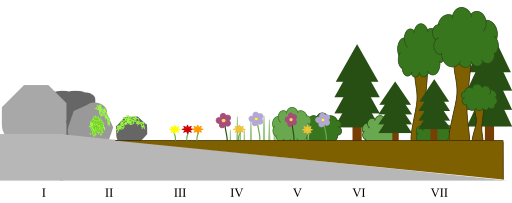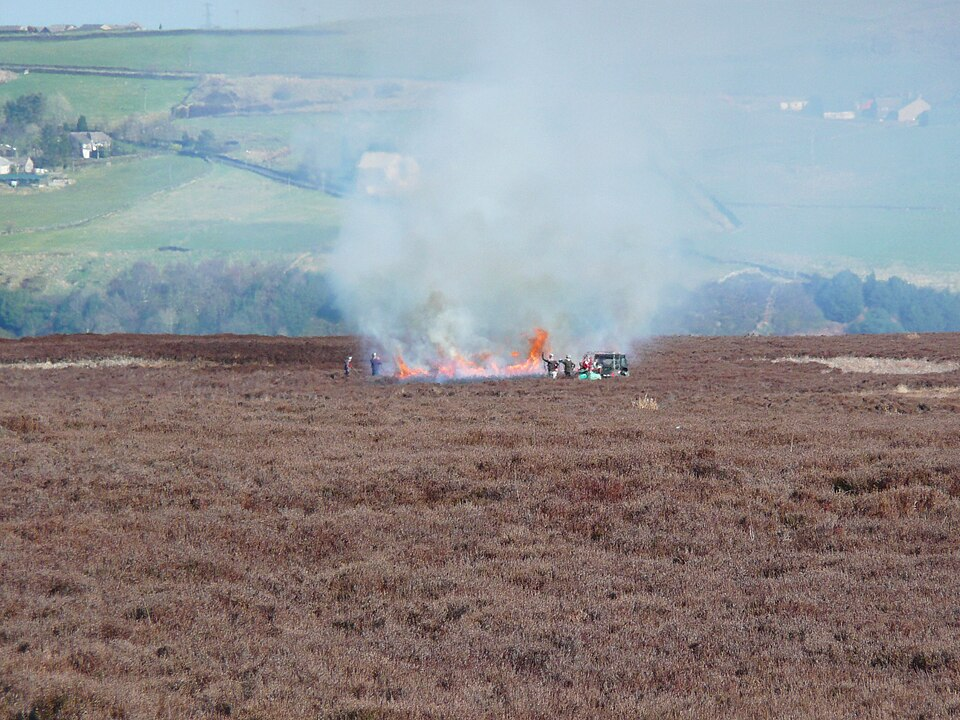OCR Specification focus:
‘Explain succession from pioneer species to a climax community and describe how human activities can cause deflected succession.’
Succession describes the gradual, directional change in an ecological community over time, driven by interactions between organisms and their environment, ultimately leading to a stable climax community.
Primary Succession
Definition and Context
Primary succession occurs in areas where no soil or previously existing community is present, such as newly formed volcanic islands, glacial moraines, or bare rock surfaces after landslides. This process illustrates how biotic and abiotic factors interact to establish life in initially uninhabitable environments.
Primary Succession: The sequence of species colonisation and ecosystem development beginning from a barren, abiotic surface with no pre-existing soil or organic matter.
Unlike secondary succession, which follows disturbance in pre-existing ecosystems, primary succession starts from scratch, requiring the formation of soil through pioneer species activity.

Primary succession is shown progressing from exposed rock through lichens/mosses to grasses, shrubs, and woodland, culminating in a climatic climax community. Soil depth and species diversity increase as pioneer and subsequent species modify abiotic conditions. This reflects the directional and predictable nature of succession described in the OCR specification. Source.
Pioneer Species and Early Stages
The first colonisers, known as pioneer species, are specially adapted to survive harsh, abiotic conditions such as strong winds, temperature extremes, and nutrient-poor substrates. Common examples include lichens, mosses, and algae.
Intermediate Stages
Once soil depth and nutrient content increase, new plant species such as grasses and herbs can establish. These plants further modify the environment by:
Enhancing soil structure through root growth.
Increasing organic matter via litter fall and decay.
Creating microhabitats for invertebrates, fungi, and microorganisms.
As the ecosystem develops, biodiversity increases, leading to more complex food webs and greater biotic interactions. Shrubs and small trees follow, contributing to shade creation and microclimatic stability, which favour shade-tolerant species.
Climax Community
The final stage of succession is the climax community, a relatively stable and self-sustaining ecosystem that exists in equilibrium with the prevailing climate, soil, and topography.
Climax Community: The final, stable community in a succession that remains relatively unchanged until disrupted by external forces.
In the UK, for example, temperate deciduous woodland represents a typical climatic climax community, containing species such as oak, ash, and beech.
At this stage:
Species diversity is high but stabilised.
Energy flow and nutrient cycling reach equilibrium.
Gross primary productivity (GPP) equals respiration (R) on average, maintaining steady biomass levels.
Deflected Succession
Human Influence on Succession
Human activities frequently alter natural successional pathways through processes known as deflected succession or plagioclimax formation.
Deflected Succession: A form of succession where human intervention prevents or alters the natural progression towards a climatic climax community, resulting in a stable but human-maintained ecosystem (plagioclimax).
Examples of deflection include mowing, grazing, burning, and deforestation. These actions halt succession at earlier stages, maintaining ecosystems in semi-natural forms that may be valued for biodiversity, aesthetic, or economic reasons.
Examples of Deflected Succession
Grassland Management
In many parts of the UK, grasslands are maintained by grazing livestock or regular mowing.
Without intervention, grasses would be replaced by shrubs (e.g., hawthorn, bramble) and eventually woodland species.
Grazing prevents this by removing young woody plants, keeping succession in check at the grassland stage.
This plagioclimax supports species-rich meadows with plants such as buttercups and clovers, which depend on open, low-competition conditions.
Heathland Conservation
Heathlands dominated by heather (Calluna vulgaris) exist due to regular burning or cutting.
Controlled burning mimics natural disturbance, removing old growth and encouraging heather regeneration.

A planned heather burn on upland moorland arrests natural succession and maintains open heathland structure. By periodically removing mature shoots, managers promote even-aged heather mosaics and prevent encroachment by shrubs and trees, sustaining a plagioclimax. The photo depicts the practice; ecological outcomes vary with frequency and intensity. Source.
Cessation of management allows birch and pine trees to establish, driving succession towards woodland.
Thus, active management sustains heathland as a cultural landscape and biodiversity hotspot.
Agricultural Systems
Agricultural activities are extreme examples of deflected succession.
Ploughing and cropping constantly remove vegetation before communities can mature.
The resulting ecosystem remains in a pioneer or early seral stage, dependent on human inputs such as fertilisers and irrigation.
Factors Influencing Deflected Succession
Several variables determine the extent and stability of deflected ecosystems:
Frequency and intensity of disturbance (e.g., grazing pressure or mowing cycles).
Abiotic conditions, including soil fertility and moisture.
Species adaptability, as some plants recover faster after disturbance.
Socioeconomic goals, such as farming, recreation, or conservation priorities.
When management ceases, natural succession usually resumes, gradually progressing toward the climatic climax unless other limiting factors intervene.
Secondary Concepts: Plagioclimax and Managed Succession
The term plagioclimax is closely related to deflected succession and describes the stable community maintained by human activity.
Plagioclimax: A community that remains stable due to ongoing human interference preventing natural succession from reaching the climatic climax.
Examples include pasturelands, mown parks, and managed heathlands. These systems can possess high ecological value, supporting unique assemblages of flora and fauna not present in unmanaged environments.
Managed succession is an important conservation strategy, balancing natural processes with biodiversity preservation. For instance, National Trust and Wildlife Trust sites often use rotational cutting, controlled grazing, and fire management to sustain desired habitats.
Summary of Key Processes in Succession
Colonisation by pioneer species begins ecological development.
Soil formation enables further plant establishment.
Community complexity increases through species interactions.
Climax community represents equilibrium with abiotic conditions.
Human activity may deflect or arrest succession, maintaining ecosystems at earlier stages for conservation or resource management purposes.
FAQ
Soil composition determines which plant species can establish and how quickly succession progresses.
Nutrient-rich soils support faster growth and greater species diversity, leading to rapid progression towards a climax community.
Poor, sandy, or acidic soils slow succession by limiting plant growth and microbial activity.
The presence of decomposers enhances nutrient cycling, accelerating later stages of succession.
Over time, as organic matter accumulates, soil texture and structure improve, allowing deeper-rooted and more competitive species to dominate.
Several abiotic factors may restrict colonisation and plant growth:
Lack of moisture prevents seed germination and microbial activity.
Extreme temperatures limit enzyme activity and species survival.
High wind exposure can desiccate plants and erode forming soil.
Low nutrient availability delays development of vegetation and humus.
Succession only proceeds once these conditions moderate, often due to the gradual effects of pioneer species altering their environment.
As succession progresses, environmental conditions become less extreme and more stable.
Increased soil depth and fertility support a wider range of plant species.
Structural complexity (e.g. multiple canopy layers) provides more habitats.
Mutualistic interactions such as pollination and seed dispersal networks enhance species interdependence.
The rise in niche diversity reduces competition pressure, and ecosystem stability improves because species compensate for one another when environmental changes occur.
Conservationists apply ecological succession principles to maintain or restore desired habitats.
Controlled burning or seasonal grazing keeps heathlands from progressing to woodland.
Rotational cutting in meadows maintains early-successional species.
In restoration projects, introducing pioneer plants jump-starts soil formation and nutrient cycling.
Understanding successional dynamics enables managers to decide whether to encourage natural progression or maintain a plagioclimax for species that depend on earlier stages.
Autogenic succession is driven by biotic changes caused by organisms within the community, such as soil development, shading, and organic matter accumulation.
Allogenic succession results from external abiotic influences, including floods, volcanic activity, or climate change.
In most ecosystems, both processes interact: autogenic changes gradually shape the environment, while allogenic factors can reset or redirect the successional pathway.
Practice Questions
Question 1 (2 marks)
Explain the role of pioneer species in the process of primary succession.
Mark scheme:
1 mark for identifying that pioneer species are the first organisms to colonise barren environments such as bare rock.
1 mark for describing a function they perform, e.g. they break down rock and accumulate organic material when they die, leading to the formation of soil/humus that enables other species to establish.
Question 2 (5 marks)
Describe how human activities can cause deflected succession, and explain how this results in the formation of a plagioclimax community.
Mark scheme:
Award up to 5 marks as follows:
1 mark for recognising that deflected succession occurs when humans prevent the natural progression of succession.
1 mark for naming or describing a human activity that causes deflection, e.g. grazing, mowing, burning, or ploughing.
1 mark for explaining that such activity removes or prevents establishment of later-successional species (e.g. trees or shrubs).
1 mark for stating that the ecosystem is maintained at an earlier seral stage (e.g. grassland or heathland) due to continued management.
1 mark for defining or describing a plagioclimax community as a stable community maintained by human interference, rather than the natural climatic climax.

